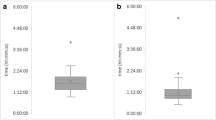Abstract
Methicillin-resistant Staphylococcus aureus (MRSA) vancomycin minimum inhibitory concentrations (V-MICs) are sometimes reported to be higher according to Etest versus broth microdilution (BMD). These observations are often interpreted as an Etest overestimation of the actual MIC. We measured V-MIC of 484 MRSA blood isolates using Etest, BMD, and a modified BMD (M-BMD) with incremental dilutions parallel to the Etest scale, correlated the results with population analysis profile–area under the curve (PAP-AUC). All MIC tests were done in parallel. The mean V-MIC was comparable (1.83 ± 0.44 [Etest], 1.88 ± 0.67 [BMD] and 1.75 ± 0.57 mg/L [M-BMD]; p = 0.9 [ANOVA]). The V-MICs/PAP-AUC correlation coefficient was 0.555 (Etest), 0.513 (BMD), and 0.586 (M-BMD). Etest MICs were equal (44.2 %), one dilution higher (21.9 %), two dilutions higher (2.5 %), one dilution lower (29.8 %), and two dilutions lower (1.6 %) than BMD MICs and were equal (61.5 %), one dilution higher (28.3 %), two dilutions higher (0.4 %), one dilution lower (9.5 %), and two dilutions lower (0.2 %) than M-BMD MICs. The mean PAP-AUC for Etest vs M-BMD among isolates with similar Etest/M-BMD MIC values was 0.25 ± 0.15 vs 0.35 ± 0.13 (p = 0.8), 0.46 ± 0.16 vs 0.50 ± 0.17 (p = 0.8), 0.64 ± 0.19 vs 0.67 ± 0.21 (p = 0.9), and 0.90 ± 0.31 vs 0.88 ± 0.25 (p = 1.0) for isolates with V-MIC of ≤1, 1.5, 2, and ≥3 mg/L respectively. These results suggest that Etest might not overestimate V-MIC in comparison to M-BMD or BMD; Etest and M-BMD tests depict comparable PAP-AUC and have a higher correlation with PAP-AUC than the conventional BMD, probably because of the more detailed results. Etest may be more suitable than conventional BMD for MIC outcome assessment because of the more detailed MICs.


Similar content being viewed by others
References
Lodise TP, Graves J, Evans A, Graffunder E, Helmecke M, Lomaestro BM, Stellrecht K (2008) Relationship between vancomycin MIC and failure among patients with methicillin-resistant Staphylococcus aureus bacteremia treated with vancomycin. Antimicrob Agents Chemother 52:3315–3320
Mason EO, Lamberth LB, Hammerman WA, Hulten KG, Versalovic J, Kaplan SL (2008) Vancomycin MICs for Staphylococcus aureus vary by detection method and have subtly increased in a pediatric population since 2005. J Clin Microbiol 47:1628–1630
Moore CL, Osaki-Kiyan P, Haque NZ, Perri MB, Donabedian S, Zervos MJ (2012) Daptomycin versus vancomycin for bloodstream infections due to methicillin-resistant Staphylococcus aureus with high vancomycin minimum inhibitory concentration: a case–control study. Clin Infect Dis 54:51–58
Musta AC, Riederer K, Shemes S, Chase P, Jose J, Johnson LB, Khatib R (2009) Vancomycin MIC plus heteroresistance and outcome of methicillin-resistant Staphylococcus aureus bacteremia: trends over 11 years. J Clin Microbiol 47:1640–1644
Sakoulas G, Moise-Broder PA, Schentag J, Forrest A, Moellering RC Jr, Eliopoulos GM (2004) Relationship of MIC and bactericidal activity to efficacy of vancomycin for treatment of methicillin-resistant Staphylococcus aureus bacteremia. J Clin Microbiol 42:2398–2402
Soriano A, Marco F, Martínez JA, Pisos E, Almela M, Dimova VP, Alamo D, Ortega M, Lopez J, Mensa J (2008) Influence of vanco- mycin minimal inhibitory concentration on the treatment of methicillin resistant Staphylococcus aureus bacteremia. Clin Infect Dis 46:193–200
Khatib R, Jose J, Musta AC, Sharma M, Fakih MG, Johnson LB, Riederer K, Shemes S (2011) The relevance of vancomycin-intermediate susceptibility and heteroresistance in methicillin-resistant Staphylococcus aureus bacteremia. J Antimicrob Chem 66:1594–1599
Sader HS, Rhomberg PR, Jines RN (2009) Nine-hospital study comparing broth microdilution and Etest method results for vancomycin and daptomycin against methicillin-resistant Staphylococcus aureus. Antimicrob Agent Chemother 53:3162–3165
Prakash V, Lewis JS 2nd, Jorgensen JH (2008) Vancomycin MICs for methicillin-resistant Staphylococcus aureus isolates differ based upon the susceptibility test method used. Antimicrob Agents Chemother 52:4528
Jorgensen JH, Turnidge JD (2007) Susceptibility test methods: dilution and disk diffusion methods. Antibacterial agents and susceptibility test methods. In: Murray PR, Baron EJ, Jergensen JH, Landry ML, Pfaller MA (eds) Manual of clinical microbiology, 9th edn. ASM Press, Washington DC, pp 1152–1172
European Committee for Antimicrobial Susceptibility Testing (EUCAST) of the European Society of Clinical Microbiology and Infectious Diseases (ESCMID) (2000) Determination of minimum inhibitory concentration (MICs) of antimicrobial agents by agar dilution. Clin Microbiol Infect 6:509–515
Steinkraus G, White R, Friedrich L (2007) Vancomycin MIC creep in non-vancomycin-intermediate Staphylococcus aureus (VISA), vancomycin-susceptible clinical methicillin-resistant S. aureus (MRSA) blood isolates from 2001–05. J Antimicrob Chemother 60:788–794
Van Hall SB, Barbagiannakos T, Jones M, Wehrhahn MC, Mercer J, Chen D, Paterson DL, Gosbell IB (2011) Methicillin-resistant Staphylococcus aureus vancomycin susceptibility testing: methodology correlations, temporal trends and clonal patterns. J Antimicrob Chemother 66:2284–2287
Chua T, Moore CL, Perri MB, Donabedian SM, Masch W, Vager D, Davis SL, Lulek K, Zimnicki B, Zervos MJ (2008) Molecular epidemiology of methicillin-resistant Staphylococcus aureus bloodstream isolates in urban Detroit. J Clin Microbiol 46:2345–2352
Kruzel MC, Lewis CT, Welsh KJ, Lewis EM, Dundas NE, Mohr JF, Armitige LY, Wanger A (2011) Determination of vancomycin and daptomycin MICs by different testing methods for methicillin-resistant Staphylococcus aureus. J Clin Microbiol 49:2272–2273
Hsu DI, Hidayat LK, Quist R, Hindler J, Karlsson A, Yusof A, Wong-Beringer A (2008) Comparison of method-specific vancomycin minimum inhibitory concentration values and their predictability for treatment outcome of methicillin-resistant Staphylococcus aureus (MRSA) infections. Int J Antimicrob Agents 32:378–385
Wootton M, Howe RA, Hillman R, Walsh TR, Bennett PM, MacGowan AP (2001) A modified population analysis profile (PAP) method to detect hetero-resistance to vancomycin in Staphylococcus aureus in a UK hospital. J Antimicrob Chemother 47:399–403
Acknowledgement
This work was supported by St John Hospital Medical Education Fund.
Conflict of interest
None of the authors has any conflicts of interest to disclose.
Author information
Authors and Affiliations
Corresponding author
Rights and permissions
About this article
Cite this article
Khatib, R., Riederer, K., Shemes, S. et al. Correlation of methicillin-resistant Staphylococcus aureus vancomycin minimal inhibitory concentration results by Etest and broth microdilution methods with population analysis profile: lack of Etest overestimation of the MIC. Eur J Clin Microbiol Infect Dis 32, 803–806 (2013). https://doi.org/10.1007/s10096-012-1811-7
Received:
Accepted:
Published:
Issue Date:
DOI: https://doi.org/10.1007/s10096-012-1811-7




